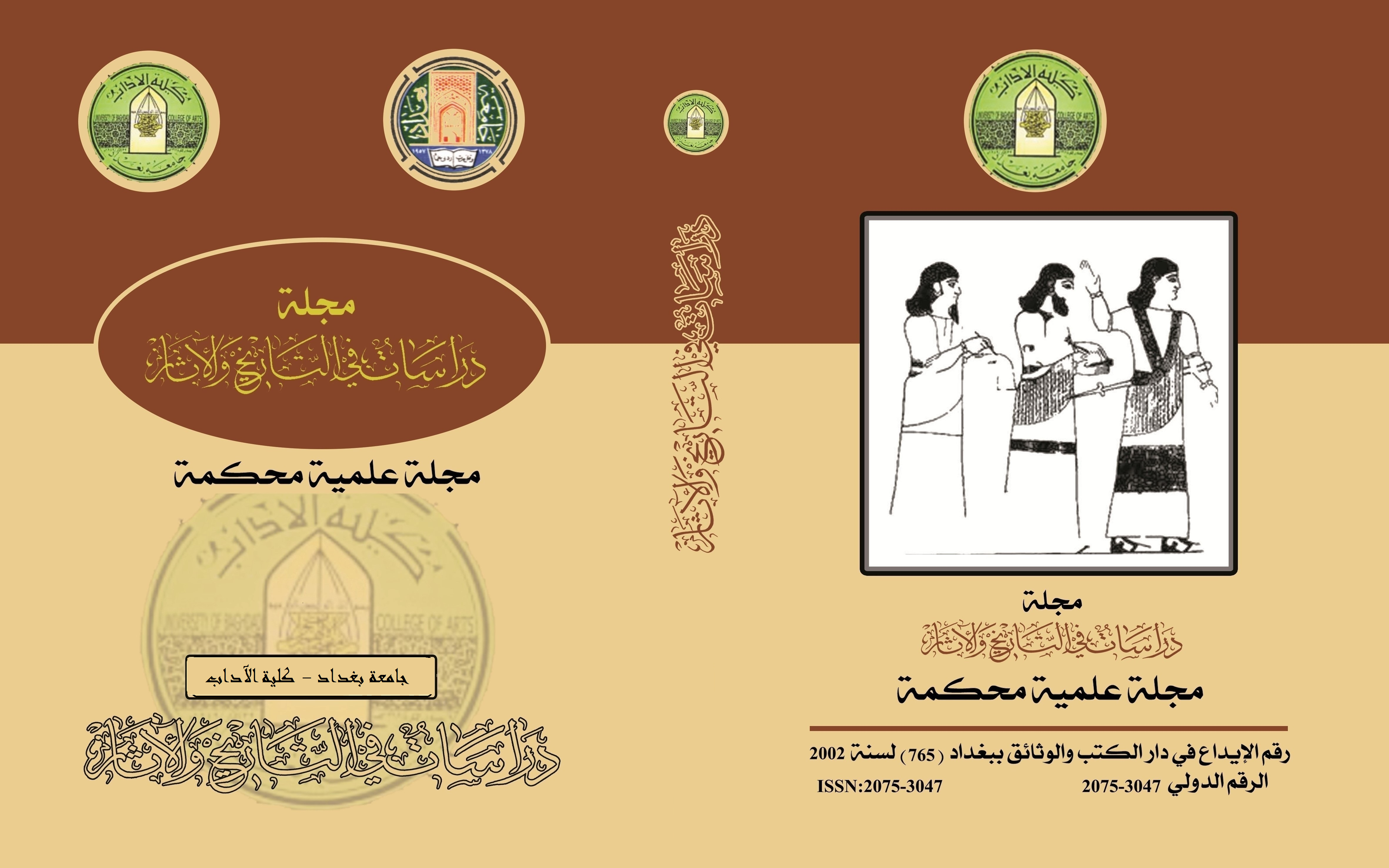شهر (iti níg-e-ga) في ضوء نصوص مسمارية غير منشورة من مدينة اري ساك رك
الكلمات المفتاحية:
نصوص مسمارية، عصر اور الثالثة، شهر (iti níg-ga-e)، اري ساك ركالملخص
ساعدت دراسة أسماء الأشهر في معرفة عائدية النصوص المسمارية فضلا عن أهميتها في معرفة الحياة الاقتصادية والاجتماعية لارتباط تسمية الأشهر بنشاطات الحياة اليومية في عصر اور الثالثة وقد تضمنت الدراسة خمسة نصوص مسمارية مصادرة أي مجهولة المعثر من مقتنيات المتحف العراقي وتعود الى مدينة اري ساك رك نسبة الى اسم الشهر (iti níg-ga-e) وهو الشهر العاشر في تقويم هذه المدينة والى أسماء الشخصيات الواردة في النصوص وقد تمت ترجمة وتحليل هذه النصوص اما المضامين العامة للنصوص فضم النص الأول تسلم كمية من الشعير، اما النص الثاني تضمن نفقات بيرة والنص الثالث توزيع زيت السمسم والنص الرابع والخامس لم نستطيع تحديد مضمونه العام وذلك بسبب تلف وجه الرقيم والنص السادس تضمن نفقات بيرة من قبل عدد من الأشخاص.
المراجع
أميرة عيدان الذهب، الكاهنات في العصر البابلي القديم في ضوء النصوص المسمارية المنشورة، رسالة ماجستير غير منشورة، جامعة بغداد، 1999.
حسن مهدي الصفار، زراعة الشعير في العراق القديم من الالف الثالث ق. م حتى نهاية العصر البابلي القديم، رسالة ماجستير غير منشورة، بغداد، 2011.
جاسم عبد الامير الجنابي، نصوص مسمارية غيرs منشورة من أرشيف التاجر تورام-ايلي 2046-2004 ق.م، رسالة ماجستير غير منشورة، جامعة بغداد، 2014.
سجى مؤيد عبد اللطيف، قواعد اللغة السومرية في ضوء نصوص سلالة لكش الاولى، اطروحة دكتوراة غير منشورة، جامعة بغداد، كلية الآداب، 2004.
عامر حمزة حسين، " وسائل وآليات العلاقات الدبلوماسية في العراق القديم" مجلة دراسات في التاريخ والآثار، العدد 36، جامعة بغداد، 2013.
علي عزاوي احمد، الفعل ومكوناته في اللغة السومرية في ضوء نصوص اقتصادية منشورة وغير منشورة من سلالة اور الثالثة، دار ومكتبة قناديل للطباعة والنشر، ط1، بغداد، 2017.
غيث سليم فرحان، الموفدون وأثرهم في العلاقات الدولية للعراق القديم (2800-539 ق. م)، أطروحة دكتوراه غير منشورة، جامعة بغداد/ كلية الآداب، 2012.
فوزي رشيد، الشراىع العراقية القديمة، بغداد، 1973.
فوزي رشيد، قواعد اللغة السومرية، دمشق، 2009.
قحطان رشيد صالح، الكشاف الأثري في العراق، الموصل، 1987، ص 258.
نوالة أحمد محمود المتولي، مدخل لدراسة الحياة الاقتصادية لدولة أور الثالثة، بغداد، 2007.
وفاء هادي زويد، نصوص مسمارية غير منشورة من عصر سلالة اور الثالثة اوما- دريهم (مصادرة)، اطروحة دكتوراة غير منشورة، جامعة بغداد، 2018.
المصادر الأجنبية:
Black, J. & George, A. & Postgate, N., A Concise Dictionary of Akkadian, (CDA), Wiesbaden, 2000
Borger, R., Assyrisch - Babylonische Zeichenliste , (AbZ), Germany , 1981.
Edzard, D.O. & Farber, G., Répertoire Géographique des Texts Cunéiformes , (RGTC-2), Weisbaden,1974.
Edzard, D.O., Sumerian Grammer, Leiden, 2003.
Falkenstein, A., Die Neusumerischen Gerichts Urkunden, (NG-III), München, 1957.
Foxvog , D.A., Introduction to Sumerian Grammar, 2009.
Halloran, J., Sumerian Lexicon ,Losangolos, 2006.
Kupper,J.R., “Le Pays Simaški” IRAQ, vo-31, 1969.
Labat, R., Manual D'epigraphie Akkadienne, (MDA), Paris, 1994.
Legrain,L,.Business Documents of the Third Dynasty of Ur,UET,vol-3, London, 1947.
Openheim,L.&Others , The Chicago Assyrian Dictionary, (CAD) , (Chicago, 1956ff ).
Owen, D.I., Cuneiform Texts Primarily From Iri-sagrig/Al-Sarraki and The History Of The Ur III Period, Nisaba -15,part-1, Maryland, 2013.
Powell, M. A."Masse und Gewichte", ( RLA- 7).Berlin, New York,1987 -1990.
Schramm, W., Akkadische Logogramme, GAAL-4 , Gottingen, 2003.
Sharlach, T.M, "Diplomacy and the Rituals of the politics at the Ur III court" , JCS- 57, 2005.
Sigrist, M., Neo-Sumerian Texts from the Royal Ontario Museum, Maryland 1995.
Sollberger , E., & Others , Répertoire Géographique des Texts Cunéiformes , (RGTC-1), Weisbaden, 1974.
Steinkeller , p., " New light on šimaški and its Rulers", ZA-97.
Thomsen, M.L., The Sumerian Language, Sum.L. ,Copenhagen,2001.
Vito, R, A., Studies in Third Millennium Sumerian and Akkadian Personal Names, Roma,1993.
التنزيلات
منشور
إصدار
القسم
الرخصة

هذا العمل مرخص بموجب Creative Commons Attribution 4.0 International License.
:حقوق الطبع والنشر والترخيص
بالنسبة لجميع البحوث المنشورة في مجلة دراسات في التاريخ والآثار، يحتفظ الباحثون بحقوق النشر. يتم ترخيص البحوث بموجب ترخيص Creative Commons CC BY 4.0 المفتوح ، مما يعني أنه يجوز لأي شخص تنزيل البحث وقراءته مجانًا. بالإضافة إلى ذلك ، يجوز إعادة استخدام البحث واقتباسه شريطة أن يتم الاستشهاد المصدر المنشور الأصلي. تتيح هذه الشروط الاستخدام الأقصى لعمل الباحث وعرضه.
:إعادة إنتاج البحوث المنشورة من الناشرين الآخرين
من الضروري للغاية أن يحصل الباحثون على إذن لإعادة إنتاج أي بحث منشورة (أشكال أو مخططات أو جداول أو أي مقتطفات من نص) لا يدخل في نطاق الملكية العامة أو لا يملكون حقوق نشرها. يجب أن يطلب الباحثون إذنًا من مؤلف حقوق النشر (عادة ما يكون الناشر).
يطلب الإذن في الحالات التالية:
بحوثك الخاصة المنشورة من قِبل ناشرين آخرين ولم تحتفظ بحقوق النشر الخاصة بها.
مقتطفات كبيرة من بحوث أي شخص أو سلسلة من البحوث المنشورة.
استخدم الجداول والرسوم البيانية والمخططات والمخططات والأعمال الفنية إذا لم يتم التعديل عليها.
الصور الفوتوغرافية التي لا تملك حقوق لنشرها.
لا يطلب الإذن في الحالات التالية:
إعادة بناء الجدول الخاص بك مع البيانات المنشورة بالفعل في مكان آخر. يرجى ملاحظة أنه في هذه الحالة يجب عليك ذكر مصدر البيانات في شكل "بيانات من ..." أو "مقتبس من ...".
تعتبر عروض الأسعار القصيرة معقولة الاستخدام العادل ، وبالتالي لا تتطلب إذنًا.
الرسوم البيانية ، الرسوم البيانية ، المخططات ، الأعمال الفنية التي أعاد الباحث رسمها بالكامل والتي تم تغييرها بشكل ملحوظ إلى درجة لا تتطلب الاعتراف.
الحصول على إذن
لتجنب التأخير غير الضروري في عملية النشر ، يجب أن تبدأ في الحصول على أذونات في أقرب وقت ممكن. لا يمكن لمجلة الآداب نشر بحث مقتبس من منشورات أخرى دون إذن.
قد يمنحك مالك حقوق الطبع والنشر تعليمات بشأن شكل الإقرار الواجب اتباعه لتوثيق عمله ؛ بخلاف ذلك ، اتبع النمط: "مستنسخ بإذن من [المؤلف] ، [كتاب / المجلة] ؛ نشره [الناشر] ، [السنة]." في نهاية شرح الجدول ، الشكل أو المخطط.



















